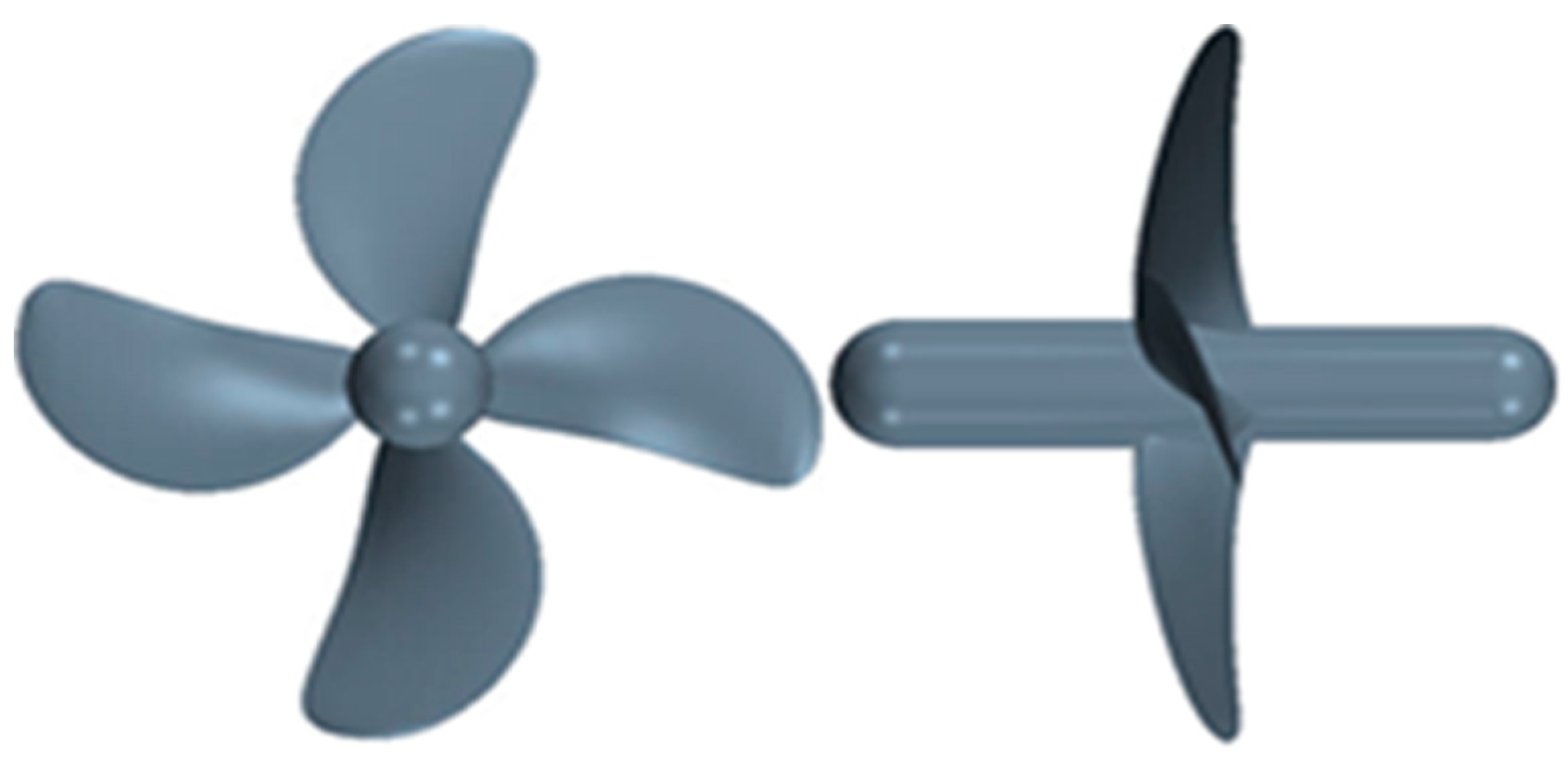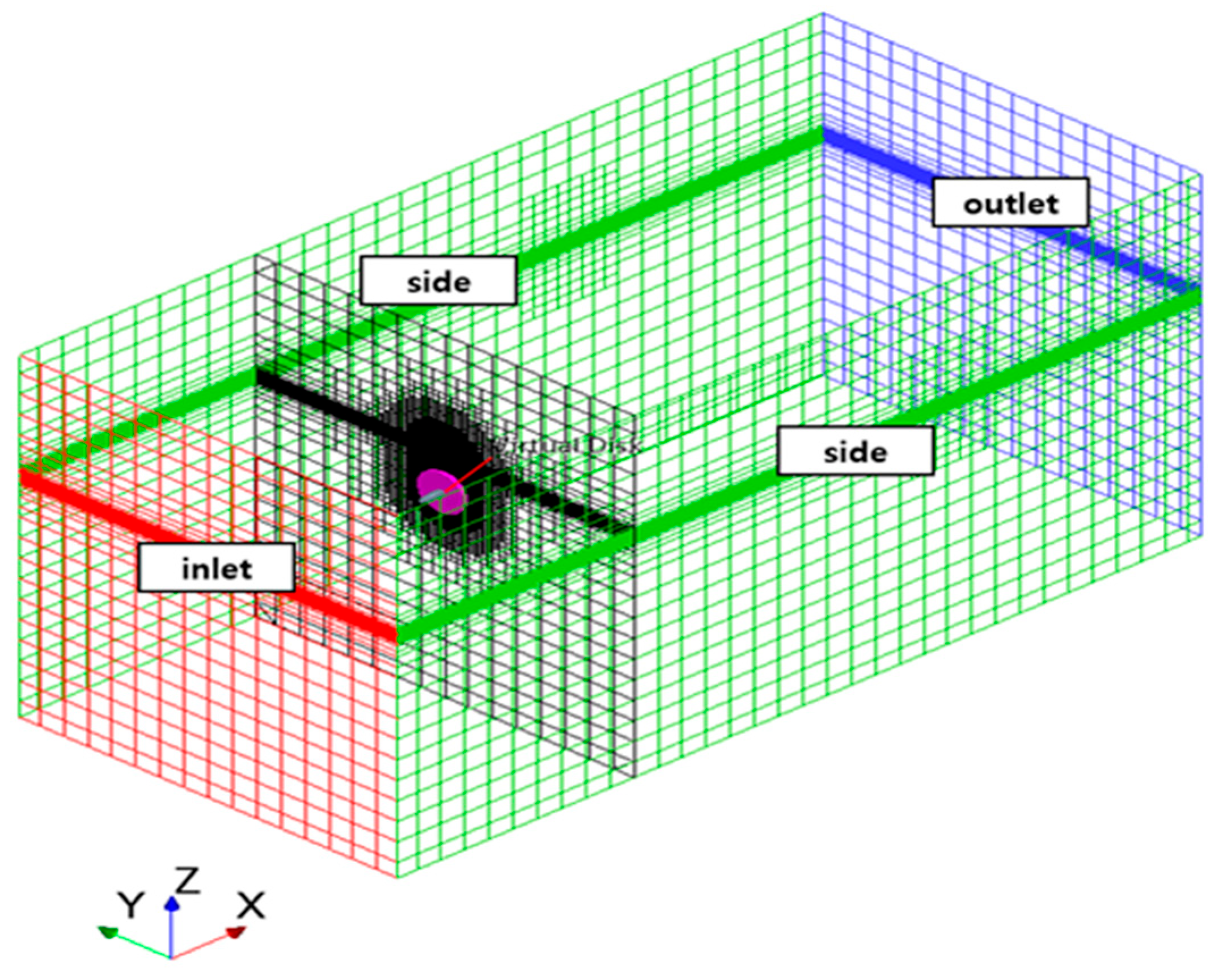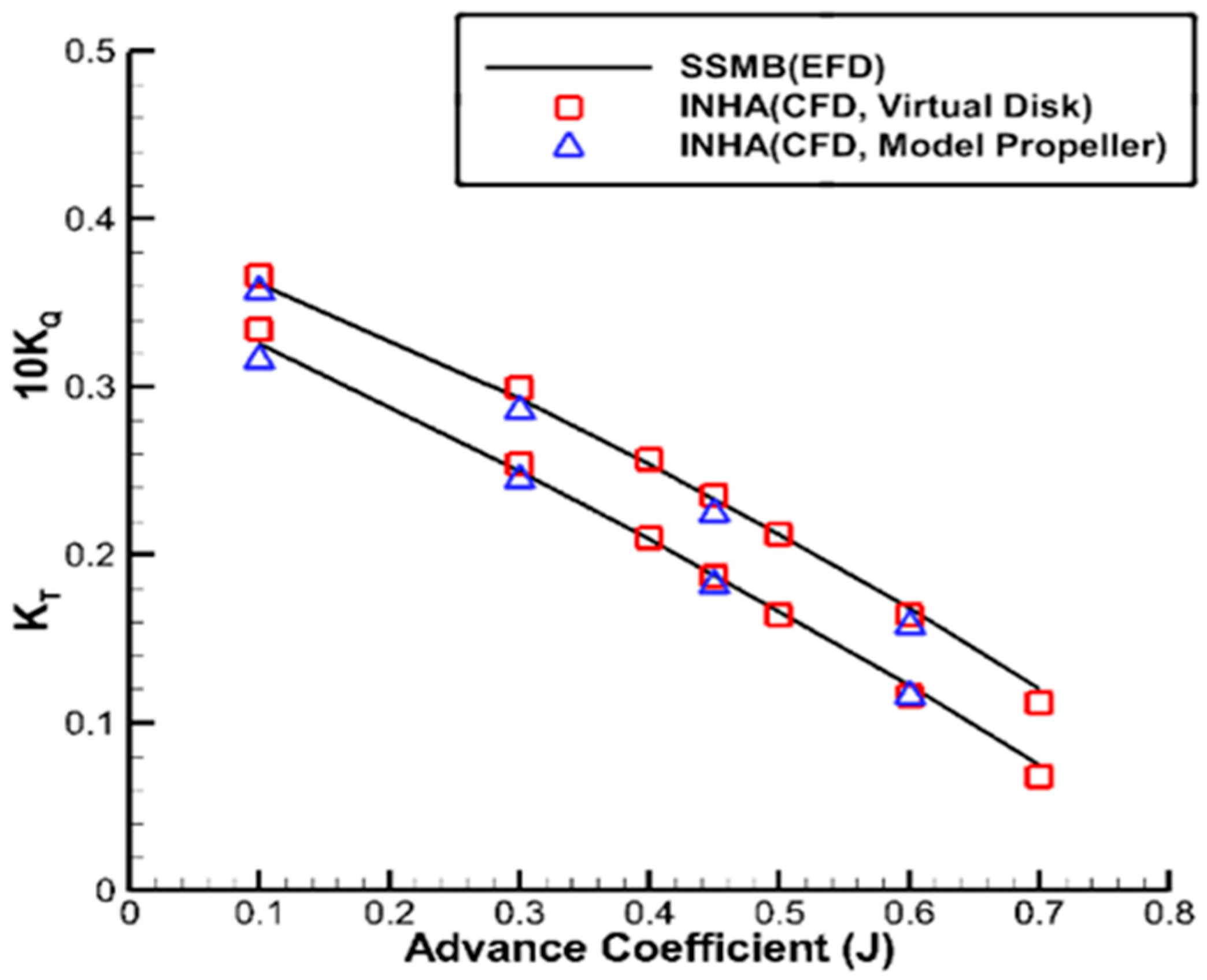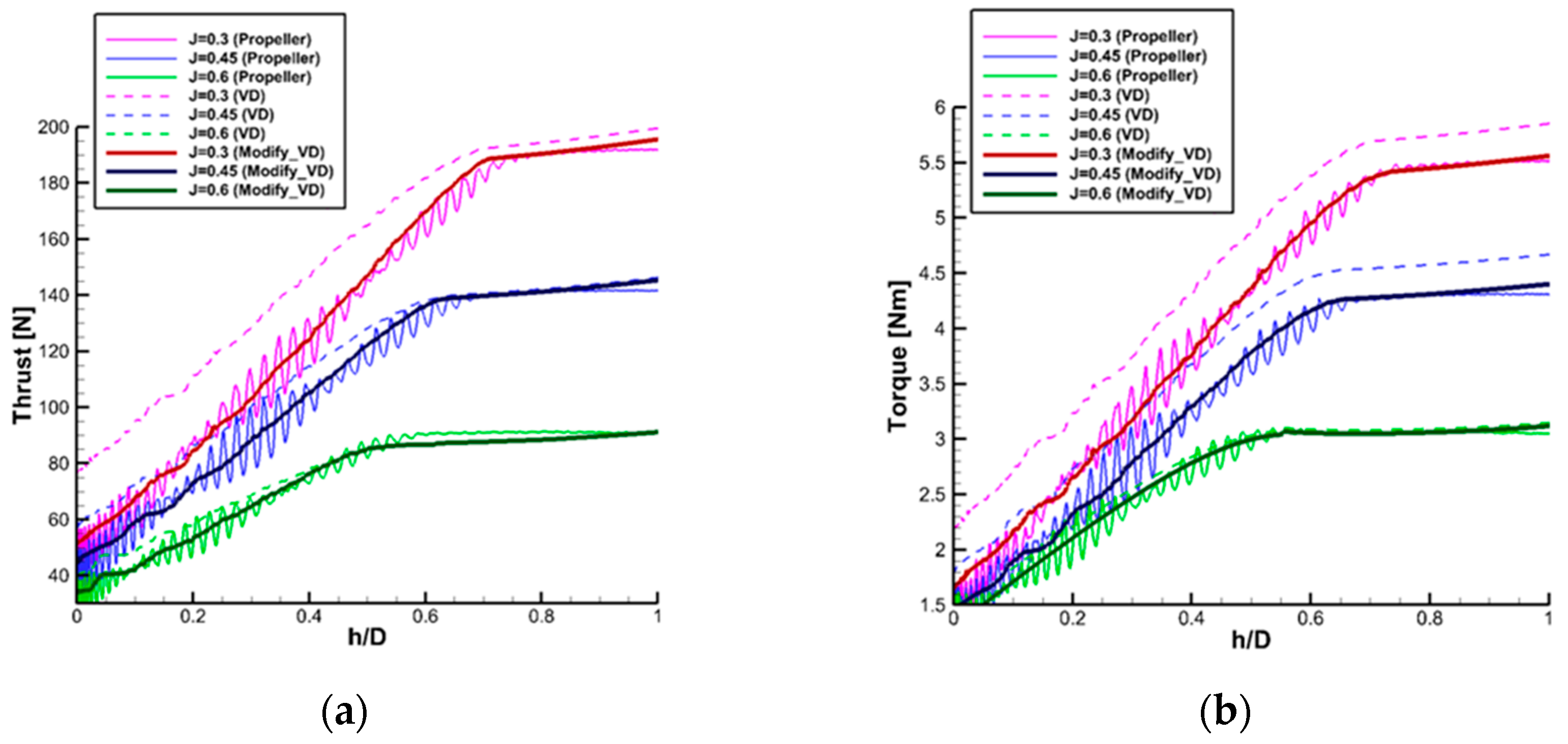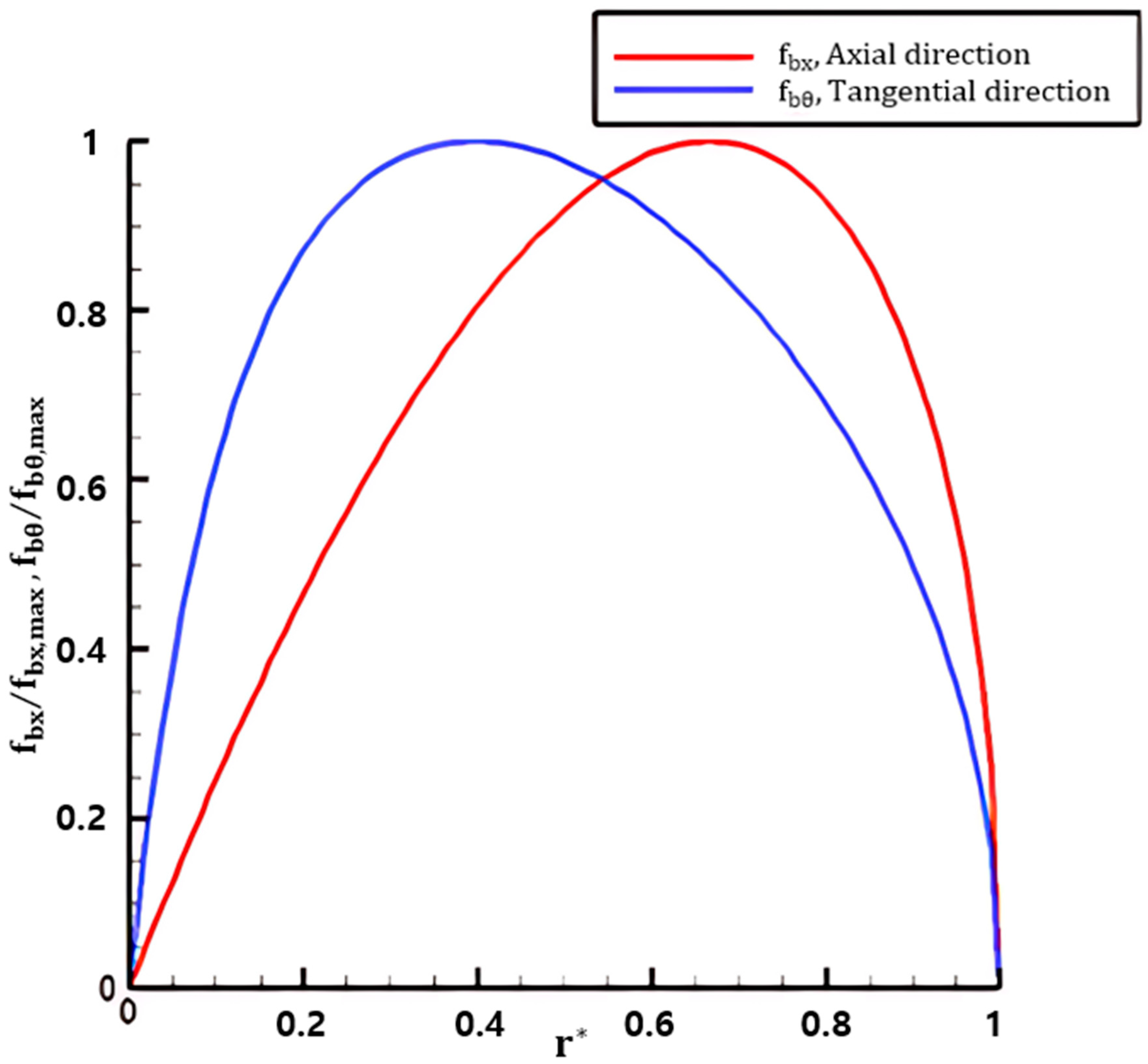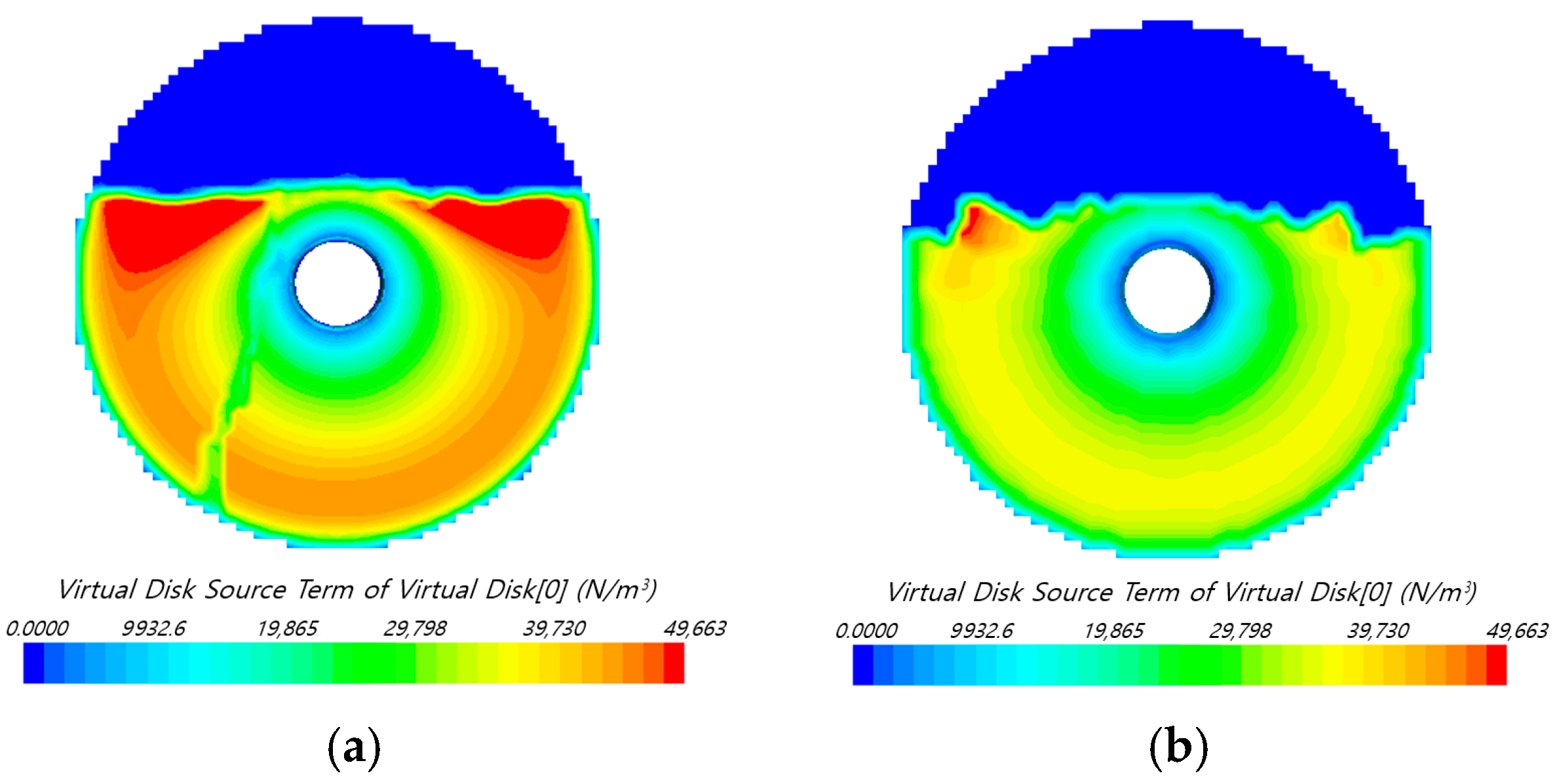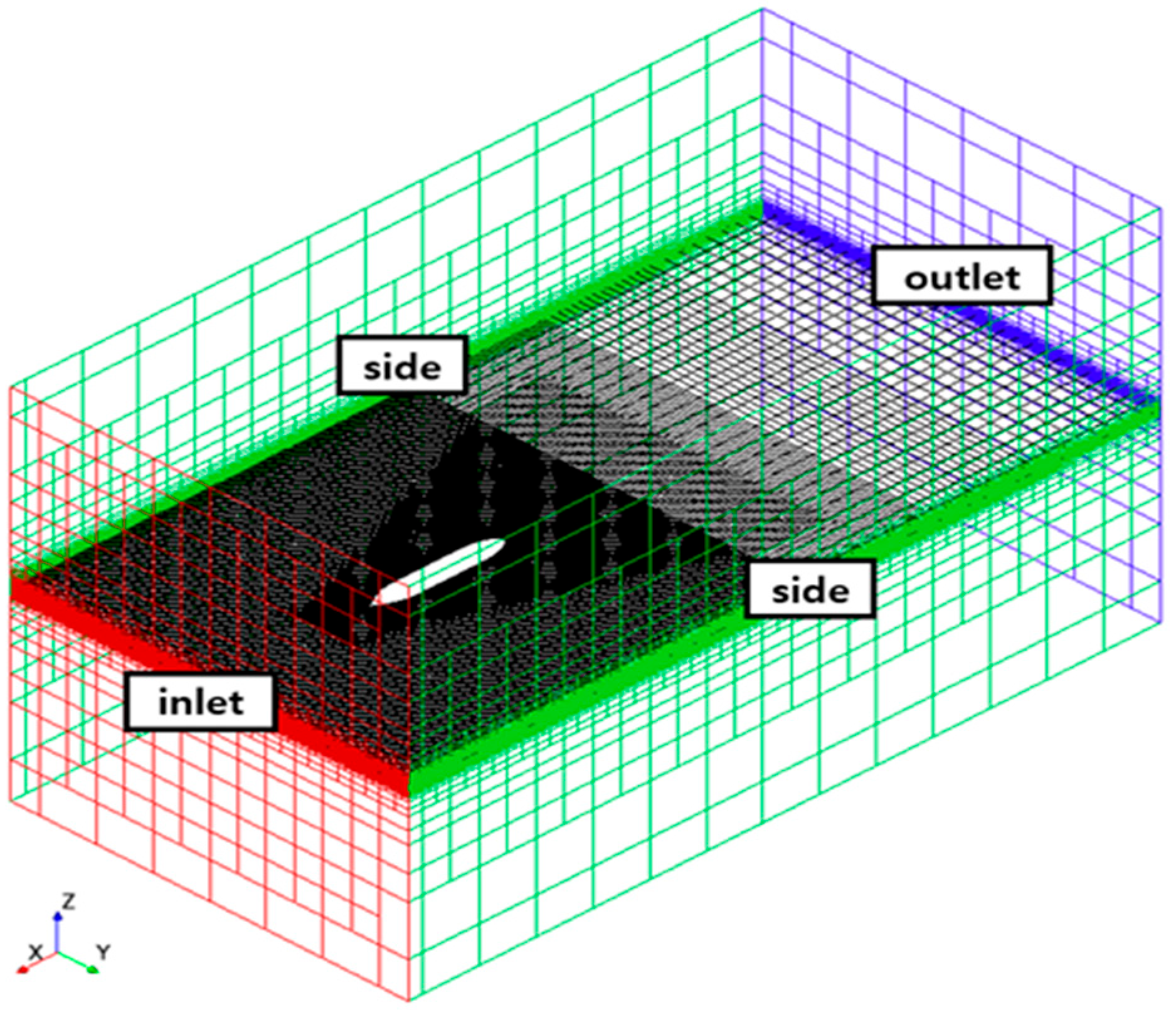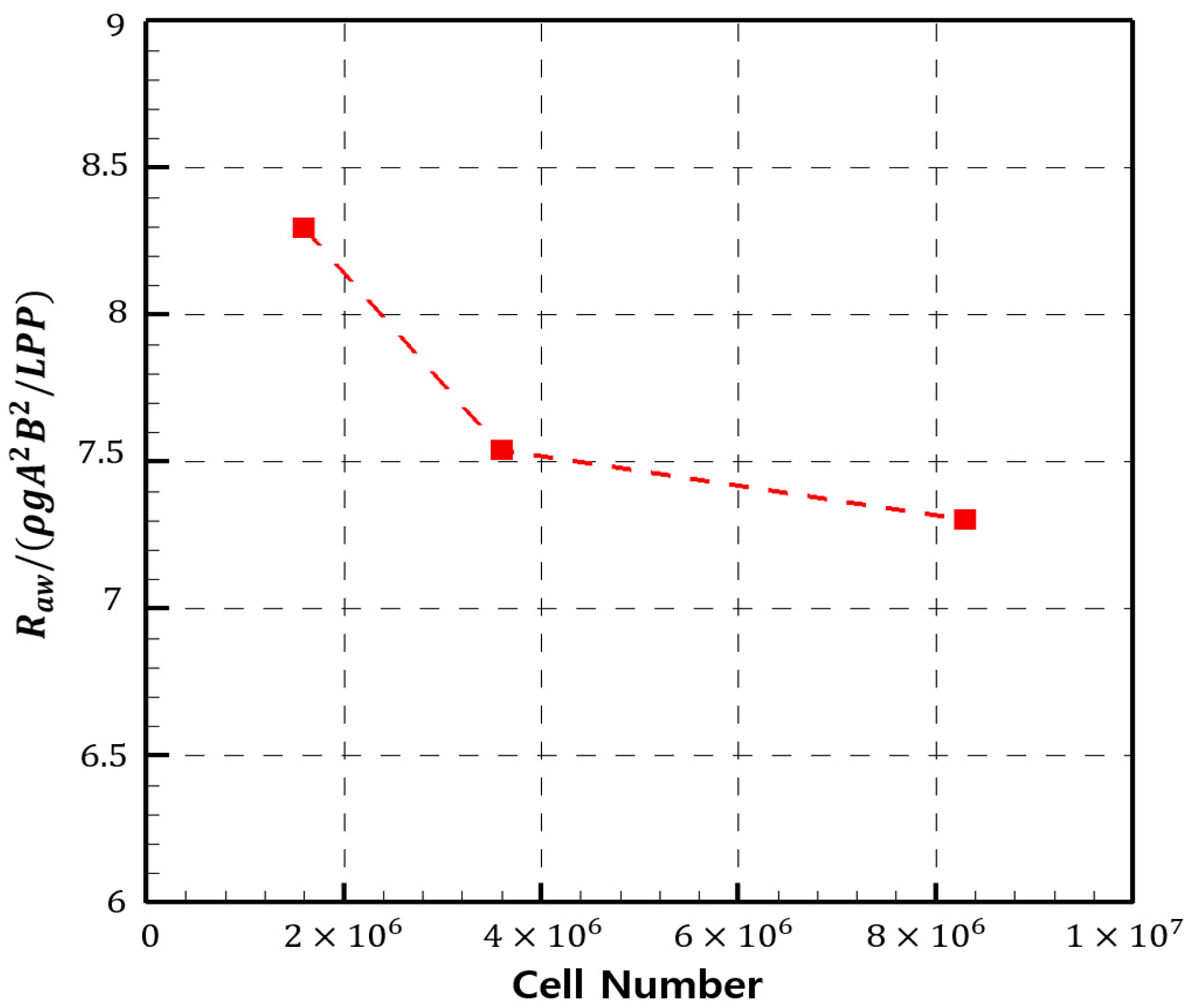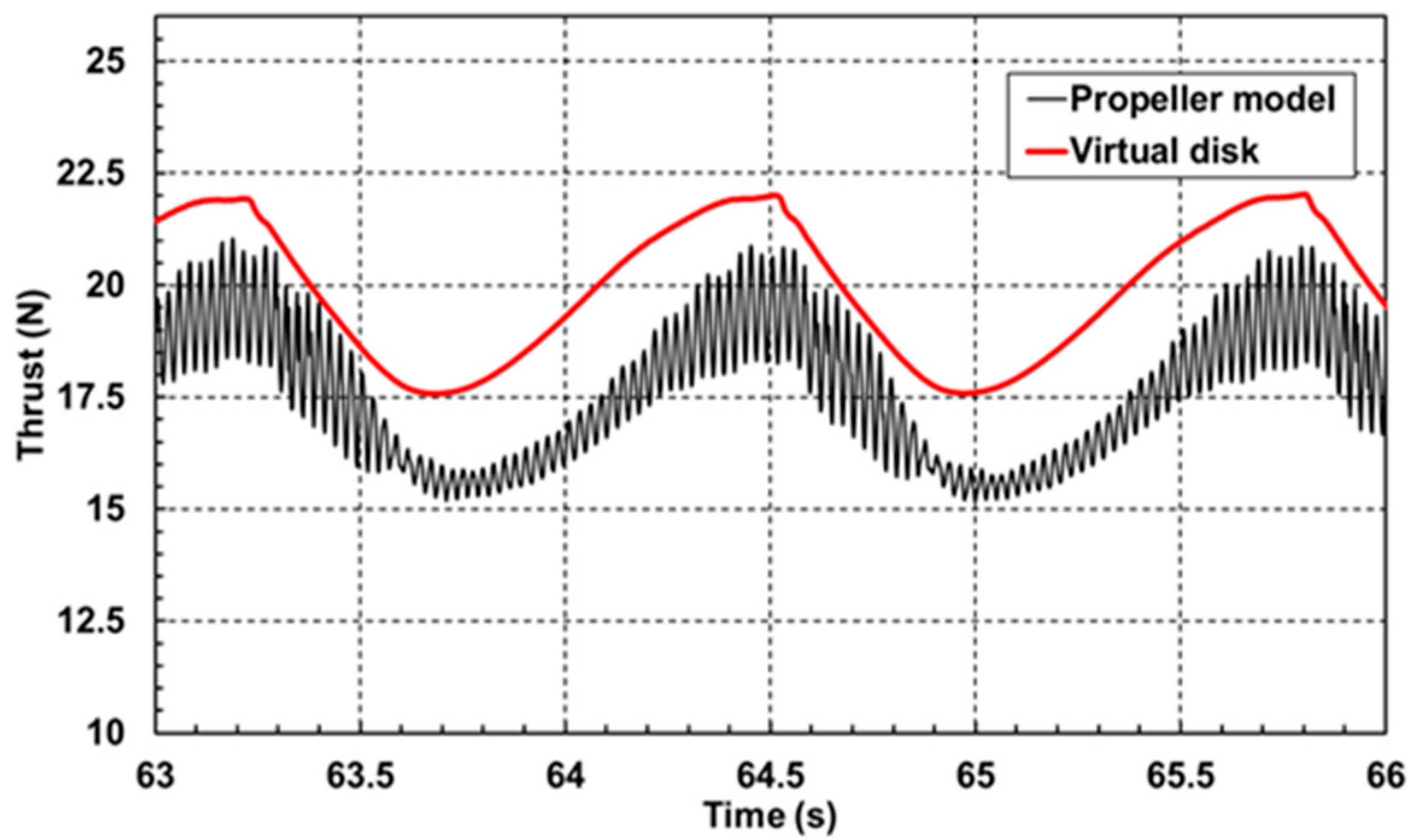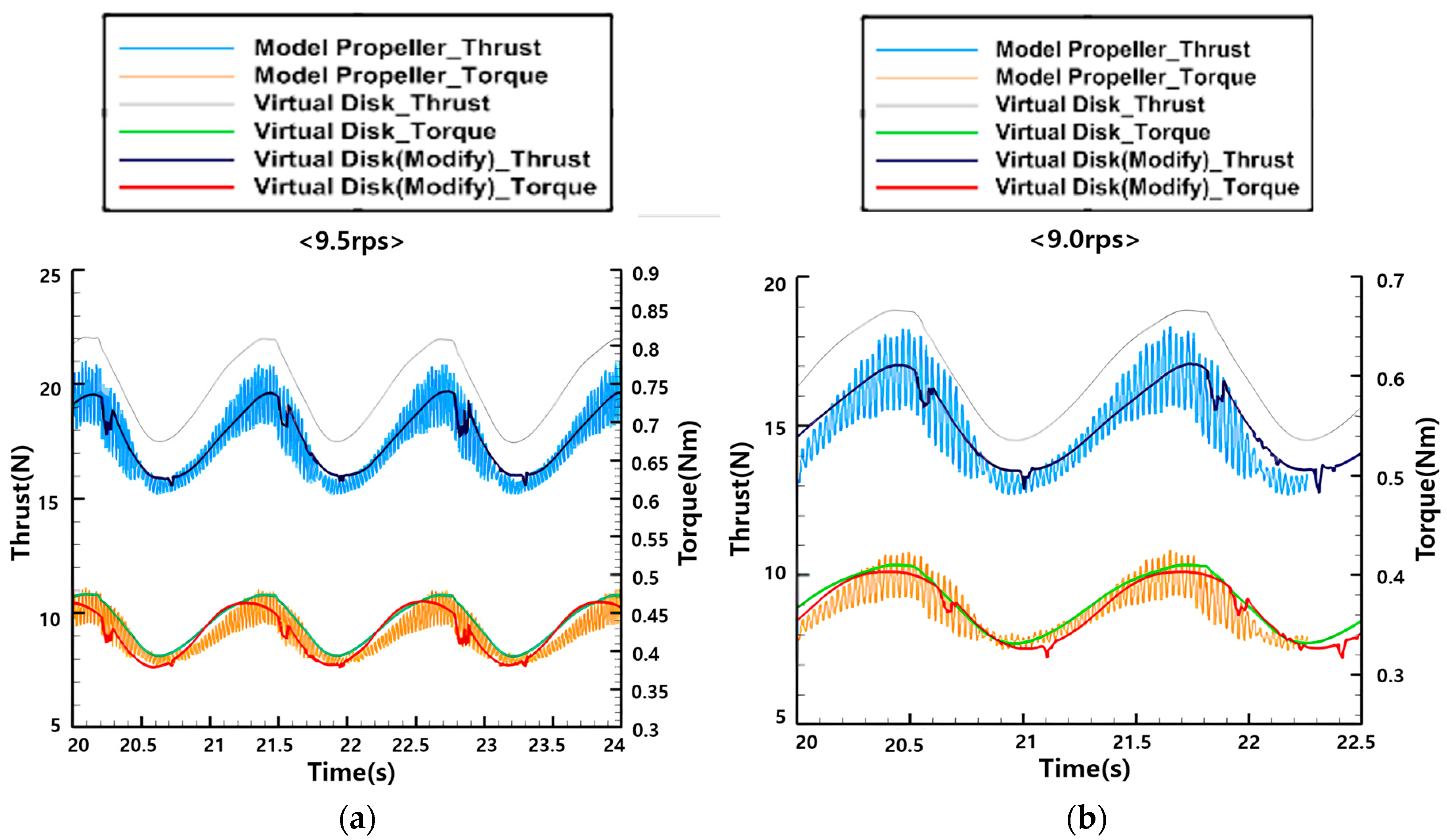1. Introduction
The International Maritime Organization (IMO) has been continuously reinforcing its strategies to reduce greenhouse gas (GHG) emissions generated by the maritime industry. In July 2023, the IMO adopted the “2023 IMO Strategy on Reduction of GHG Emissions from Ships,” aiming to achieve net-zero GHG emissions from international shipping by 2050. The intermediate targets are set to reduce emissions by at least 20% by 2030 and by at least 70% by 2040. Additionally, the IMO recommends replacing at least 5% of total energy usage with zero- or low-emission technologies, fuels, or energy sources by 2030 [
1]. As concrete measures, the Energy Efficiency Existing Ship Index (EEXI) and the Carbon Intensity Indicator (CII) have been introduced for existing vessels. Notably, the CII provides a quantitative rating (A to E) based on the annual CO
2 emissions per transport work, enabling an objective assessment of operational efficiency. As such, accurate prediction and optimization of ship propulsion systems have become essential not only for environmental compliance but also for ensuring commercial competitiveness.
To ensure the effectiveness of such international regulations, it is crucial to develop technologies capable of accurately predicting ship performance under actual operating conditions. Reliable performance prediction requires the integration of multiple factors, including waves, currents, vessel motions, and propeller–hull interactions. In particular, the accurate estimation of propeller performance, which governs propulsion efficiency, cannot be achieved by conventional methods that predict only open water thrust. Therefore, establishing advanced numerical analysis techniques based on Computational Fluid Dynamics (CFD) has become increasingly important for detailed propulsion performance evaluation.
With the rapid development of CFD techniques in recent years, studies have expanded beyond calm water conditions to include realistic sea states involving wave environments. CFD simulations based on Reynolds-Averaged Navier–Stokes (RANS) equations are particularly advantageous for predicting nonlinear fluid–structure interactions under wave conditions. Tezdogan et al. [
2] demonstrated that CFD predictions under regular waves show strong correlation with experimental data, validating the reliability of CFD as a tool for simulating realistic ocean conditions [
3].
Accurate prediction of ship propulsion performance depends primarily on the precise calculation of thrust and torque generated by the propeller. Traditionally, experimental evaluations using model propellers have been widely employed, and in CFD environments, detailed modeling of actual propeller geometries has also been commonly utilized. However, such approaches require extremely fine mesh resolutions and small time-steps, leading to high computational costs and excessively long simulation times. As an alternative, the Virtual Disk (VD) method has been proposed. In this approach, the actual propeller geometry is replaced by a uniformly distributed momentum source over a circular disk. The fundamental assumption is that the mean thrust and torque produced by the propeller can be represented without explicitly resolving blade-scale flow structures. Within this framework, the governing equations are solved with additional momentum source terms in the axial and tangential directions, derived either from propeller open-water characteristics or from analytical distributions such as Goldstein’s optimum circulation. By avoiding the need for detailed blade geometry in the computational grid, the VD method substantially reduces computational cost. Due to this efficiency, the VD method has been widely employed in early-stage ship design, parametric studies of hull–propeller interactions, and performance assessments under calm and wave conditions. Nevertheless, because free-surface effects such as ventilation and partial submergence are not inherently captured, modifications are required to extend its applicability to shallow-draft and ballast conditions. Recently, the VD method has also been applied to more complex scenarios, including combined wave conditions, asymmetric hull forms, and the presence or absence of energy-saving devices (ESDs). Tokgoz et al. [
4] applied the VD method under wave conditions to perform self-propulsion analysis and demonstrated good agreement with experimental wake and thrust results [
5,
6].
The VD method performs well when the propeller is deeply submerged; however, when the propeller operates near the free surface, physical limitations can lead to significant discrepancies between the predicted and actual propulsive performance. This is particularly evident under ballast conditions, where the ship’s draft is reduced and the submergence depth of the propeller becomes shallower. Consequently, complex phenomena such as ventilation, surface piercing, and distorted particle acceleration occur. These free-surface interactions are difficult to capture with conventional VD models, often resulting in overestimation or underestimation of thrust and torque compared to experimental measurements. Ha [
7] reported that, under ballast conditions, the conventional VD method failed to reproduce actual propeller performance accurately, as observed in self-propulsion tests [
8].
To address this issue, recent studies have proposed correction models that use advance ratio (J) and submergence ratio (
) as key parameters. Eom et al. [
9] developed a correction model compatible with CFD implementation, which was applied as a field function in STAR-CCM+. This correction dynamically adjusts the body force distribution based on real-time variations in propeller submergence, thereby enabling time-dependent correction of thrust and torque. Generally, under calm water conditions, there is a minimal difference in performance between the model propeller and the conventional VD method. However, when the submergence ratio (
) falls below 0.5, the discrepancy becomes significant. The conventional VD method does not account for unsteady flow effects caused by free-surface interactions, such as cavitation and flow separation, which can lead to inaccurate performance predictions [
7,
10]. In contrast, the corrected VD method, incorporating the model, has been shown to produce results that closely match experimental thrust and torque distributions [
11].
In parallel, several numerical improvements have been proposed to enhance the precision and applicability of the VD method. Youn et al. [
12] conducted numerical studies on small fishing vessels of various sizes and quantitatively demonstrated the impact of submergence depth variations on self-propulsion performance under wave conditions. Kang et al. [
13] emphasized the need for incorporating free-surface interference effects into early-stage design and suggested the potential of body-force-based methods, such as the VD approach, as practical design tools. Zhou et al. [
10] further analyzed cavitation and ventilation phenomena near the free surface using CFD coupled with the Volume of Fluid (VOF) method and systematically examined the influence of submergence depth and inflow velocity, highlighting the limitations of conventional VD models [
14].
This study aims to overcome the limitations of the conventional virtual disk method in accounting for free-surface interactions and to develop and validate an improved body-force method that can more accurately predict actual propeller performance. To this end, performance differences between the model propeller and the conventional VD method are quantitatively analyzed, and a simplified correction model based on the key variables, advance ratio (J) and submergence ratio (), is implemented as a field function within the CFD framework. The correction model is formulated to allow for real-time dynamic adjustment based on time-dependent submergence variation.
First, open water (POW) simulations including vertical motion are conducted under calm-water conditions to quantitatively compare the performance of the model propeller and the improved Virtual Disk (VD) method. Subsequently, the same approach is applied to self-propulsion analysis under ballast conditions in waves to evaluate its applicability and reliability in realistic operating scenarios. Through this procedure, the proposed method is assessed in terms of both accuracy and applicability. The VD approach inherently reduces computational demand compared with fully discretized propeller CFD, since the propeller geometry is replaced by a body-force model and fine blade-resolving meshes are not required. Owing to this characteristic, the VD method has been widely utilized in numerical analyses as an efficient alternative. In this study, a correction scheme is introduced into the VD framework to enhance accuracy under free-surface interference conditions, and the focus is placed on extending and validating its applicability.
3. Propeller Open Water Test of Improved Virtual Disk Applying Modified Equation
3.1. Numerical Method
Figure 3 shows the grid conditions of POW analysis with heaving motion in calm water that we used to develop a virtual body method considering the interaction with a free surface. In order to verify the numerical model and grid, a comparison was carried out with the propeller-only performance of SP598M provided by Samsung Ship Model Basin (SSMB, Daejeon, Republic of Korea). The boundary conditions were set as symmetry conditions except for the inlet and outlet surfaces. A total of 2 million grids were used, and the grids of the free surface and the part where the propeller moves were made denser to observe the interaction with the free surface in detail. The results are shown in
Figure 4 and
Table 3. The results showed good agreement within ±3% for all advance ratios except for 0.6 and 0.7, which were relatively small values and showed no significant difference.
3.2. Development of Modified Equation Considering Free Surface
To compare the individual performance of two models according to depth ratio, analysis was conducted for advance ratios (
J) of 0.3, 0.45, and 0.6. The range of heave motion was set with submergence depth ratios (
) of 0 to 1, and the performance difference between the two models was observed. Regarding the change in propeller performance according to submergence depth, it was confirmed that both the virtual disk method and the model propeller show a significant decrease in performance at a specific submergence depth ratio (
), like previous studies. The original correction equation was simplified to be directly applicable in CFD by removing variables related to propeller angles that have minimal impact and by using thrust and torque values instead of
and
values for real-time feedback control. The final improved correction equation is expressed as Equation (1).
In Equation (1), , , and represent the time-varying values of propeller submersion depth, effective velocity, thrust, and torque obtained from numerical analysis. In addition, , are correction parameters derived from trend equations established in previous studies to reconcile differences between the two models. Specifically, indicates the instantaneous thrust difference between the conventional VD method and the model propeller, denotes the maximum torque discrepancy within the tested advance ratio range, and corresponds to the submersion depth at which rapid performance degradation begins for a given effective velocity.
The switching function α was designed to activate the correction only when physically required. Specifically, when the instantaneous submergence depth exceeds the critical submergence depth for the given advance ratio, the propeller remains sufficiently submerged and no correction is applied (α = 0). Conversely, when falls bellow , indicating that the propeller is operating closer to the free surface where rapid performance degradation can occur, the correction function is activated (α = 1). This formulation ensures that corrections are applied only in the relevant operating regime and remain inactive otherwise.
For the validation of the validity of Equation (1), the time-step values of thrust and torque measured using the virtual disk method in CFD were applied to the correction equations. The calculated values of thrust and torque using the modified formula were compared with the values of the model propeller, as shown in
Figure 5. The values shown with bold lines are the result of applying a modified formula to the values measured at each time-step using the virtual disk method in CFD. The values shown in bold lines are the result of applying a modified formular to the values measured at each time-step using the virtual disk method in CFD. When comparing propeller performance according to submergence depth, it was observed that the result of applying the modified formula was in good agreement with the average value of the model propeller.
Unlike earlier correction models that relied on more complex formulations with multiple empirical or motion-related parameters, the present work simplifies the correction into thrust- and torque-based terms, enabling direct and efficient implementation within a CFD environment. This formulation allows real-time feedback and dynamic adjustment in response to instantaneous variations in submergence ratio (). Moreover, the applicability of the proposed correction has been extended beyond calm-water open-water tests to self-propulsion simulations under both calm and regular wave conditions, thereby broadening the scope of validation.
3.3. Development of CFD Analysis Technique for Propulsion Performance Considering Free Surface Effect
The virtual disk method is a technique that generates the forces produced by a model propeller on a cylindrical disk without considering the shape of the model propeller. This is achieved by measuring the velocity and density using the inlet velocity plane and using those values to calculate the values of thrust and torque on the propeller surface. In this study, a field function was used to implement the body force propeller method, which is one of the virtual disk methods, through a user defined method to apply the improved modified formula variables consistently.
The distribution of forces follows Goldstein’s optimum method and can be expressed by Equations (2)–(5). In this equation,
represents the force in the x-axis direction, and
represents the force in the
θ direction.
denotes the hub radius of the propeller, and
represents the radius of the propeller. Goldstein’s optimum distribution is shown in
Figure 6. This force distribution was used to calculate the values of thrust and torque, which were then applied to the modified formula for evaluating the performance of the model propeller [
15].
In the numerical analysis program, a field function was used to apply the Goldstein’s optimum distribution to the virtual cylinder created along the axis of the propeller. This allowed for specifying the forces at different
r and
θ positions from the center axis. Additionally, a composite feature was used in the user defined method to output specific values for the X, Y, and Z directions. The input values for each direction are shown in Equations (6) and (7). The source term distribution for each component is shown in
Figure 7, which allows us to confirm the direction of the forces acting on each component in the virtual disk method.
To obtain the modified values of thrust and torque, Equation (1) was used to apply the modified formula to the
values in the existing virtual disk methods, which resulted in the modified
values. Then, Equations (4) and (5) were used to output the final modified
values on the disk. The Z component of the source term in the virtual disk method confirmed
Figure 8 in the region where there is a difference in thrust. It was observed that the source term became smaller after the application of the modified formula compared to the existing virtual disk method.
To validate the applicability of the modified virtual disk method in a CFD program, we implemented the modified virtual disk method in STAR CCM+ and compared the obtained thrust and torque values with those of the model propeller. The results are shown in
Figure 9. The modified virtual disk method showed good agreement with the model propeller values in most of the range except for the range of
= 0–0.2 at an advance ratio of 0.3. By verifying the propeller open-water performance of the virtual disk method, we confirmed the possibility of using the modified virtual disk method to estimate the performance of a ship in waves.
5. Conclusions
When performing a ship’s self-propulsion analysis using the existing virtual disk method, the efficiency is reduced due to surface piercing and air ventilation occurring as the propeller gets closer to the free surface in the low draft Ballast condition. Therefore, when comparing the model propeller and the existing virtual disk method in the section considering free surface, the thrust generated by the existing virtual disk method is significantly higher. To address this problem, a modified formula was presented in a previous study [
4] based on the effect of ship’s heave and pitch motion, propeller immersion depth, angle, and wave on both the model propeller and the virtual disk method. The modified formula was expressed as the advance ratio (
J) and immersion depth ratio (
). Through propeller open-water tests, the thrust and torque values obtained by the virtual disk method were corrected using the modified formula, and good agreement was confirmed with experimental values and the model propeller’s values. The objective of this study was to apply the modified virtual disk method to predict ship self-propulsion under ballast conditions. To achieve this goal, we systematically verified and analyzed a ship’s motion and additional resistance in both calm and wave conditions. The error rate of all numerical analysis results obtained in calm and wave conditions was less than 5%.
The values of thrust and torque of the model propeller were compared with those of the modified virtual disk method. The comparison showed that the corrected values from the modified virtual disk method showed good agreement with those of the model propeller except for the range of = 0–0.2 at the advance ratio of 0.3. Subsequently, the propeller performance in the ballast conditions under waves was compared using a model propeller, the existing virtual disk method, and a modified virtual disk method.
Generally, the wake fraction and thrust deduction coefficient tended to decrease under waves compared to calm water conditions. However, the existing virtual disk method failed to accurately represent air ventilation in the region where the free surface interference occurs compared to the model propeller. This resulted in excessive thrust and torque due to the faster inflow velocity and showed an increase in wake fraction and thrust deduction coefficient under waves compared to calm water conditions. However, the modified virtual disk method showed a decreasing trend in the wake fraction and thrust deduction coefficient under waves compared to calm water conditions and showed a high level of agreement in thrust and torque trends with the model propeller. Therefore, this study demonstrated the feasibility of using the modified virtual disk (VD) method, which requires relatively low computational cost, to estimate propeller performance in waves for future self-propulsion tests.
While the present validation in waves was limited to regular head seas with a relatively low steepness (H/λ = 0.01), the results confirmed that the modified VD method can reliably capture free-surface effects under these simplified conditions. Furthermore, since all simulations were performed at model scale, potential scale effects should be considered when applying the results to full-scale ships. Free-surface ventilation and partial submergence are expected to scale nonlinearly and could amplify thrust and torque discrepancies at full scale. Future work will therefore extend the validation to higher steepness, irregular spectra, and oblique wave incidence, and address scale effects to further broaden the applicability of the proposed method to practical ship design and operation.

